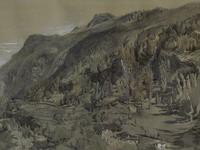John Ruskin and the Geographical Imagination
Denis Cosgrove selects works from Ruskin’s Teaching Collection and reveals a poetry of landscape that inspired geographical learning a century ago.

Ruskin’s concern with the exact rendering of the meanest and least remarked of plants, flourishing in scarcely favourable circumstances, indicates not only his sensitivity to picturesque decay but a broader, almost ecological concern for the appropriateness of connections between every form of life and its 'appointed' physical location.

Oxford Ivy (Lynaria Cymbalaria)
'The "Erba della Madonna" of Venice, or "Oxford weed" is chosen instead of common ivy: the cluster of it was drawn in a nook behind one of the shafts of the destroyed San Zaccaria at Venice.' (21:115)
Wild rose running in a cleft of Derbyshire limestone (21:210)
'Time was (when I began drawing) that I used to think a picturesque or beautiful tree was hardly to be met with once a month; I cared for nothing but oaks a thousand years old, split by lightning or shattered by wind … Now, there is not a twig in the closest-clipped hedge that grows, that I cannot admire, and wonder at, and take pleasure in, and learn from … Now this power of enjoyment is worth working for, not merely for enjoyment, but because it renders you less imperfect as one of God’s creatures - more what He would have you…' (Letter to Edward Clayton, 1841)

Study of Gneiss Rock, Glenfinlas
One of the best known of Ruskin’s drawings, he had it photographed and prints circulated. 'All touched and troubled, like waves by a summer breeze; rippled, far more delicately than seas or lakes are rippled: they only undulate along their surfaces - this rock trembles through its every fibre, like the chords of an Eolian harp: like the stillest air of spring with echoes of a child’s voice.' (6:152 and see also 6:368)
References
All references to Ruskin's writings are taken from The Works of Ruskin, Library Edition, 39 volumes, edited by E.T. Cook and Alexander Wedderburn, George Allen, London, 1903-1912 and given by volume number and page.





